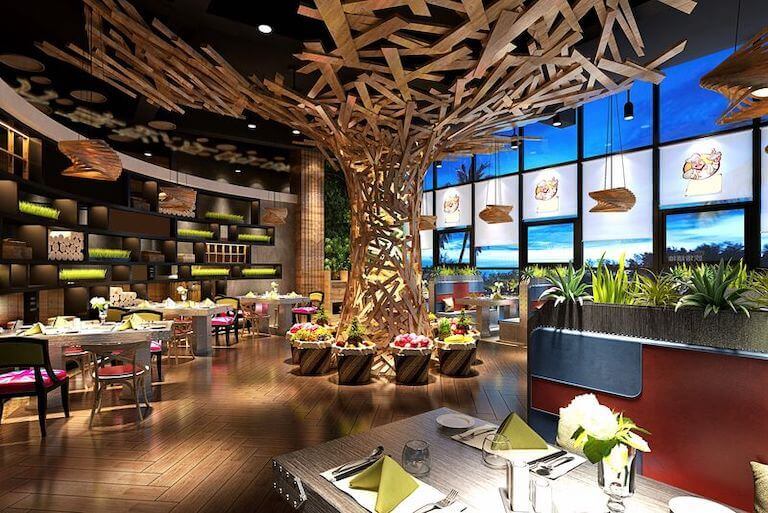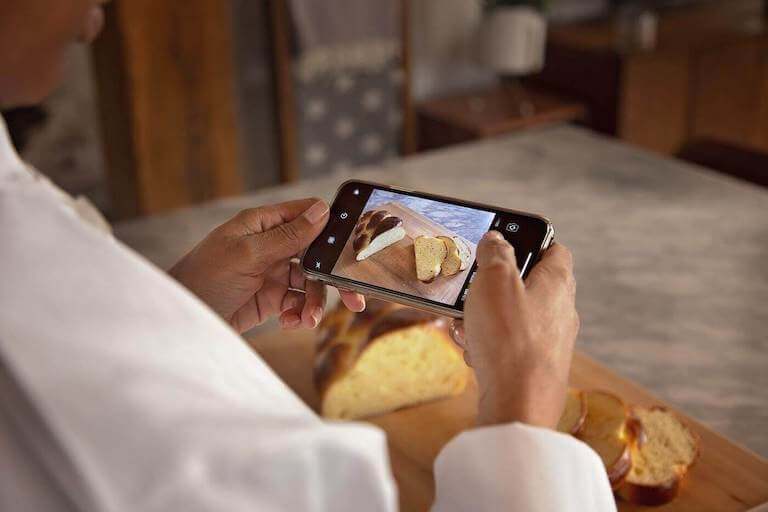Listen to This Article:
When you run a successful restaurant, you have a lot to keep track of. You strive for a beautiful storefront, stellar staff, and enticing menu items. But to stay afloat, any restaurant also needs to continually brainstorm how to attract customers. Of course, creating a keen sense of loyalty through a highly optimized marketing mix can help.
So whether you’re a first-time restaurant owner or looking to bolster your current restaurant marketing strategy, keep scrolling to unpack our essential Restaurant Marketing 101 guide.
Shape Your Brand Identity

Consider your restaurant ambiance when defining your brand identity.
The first step in your marketing plan is to spend time defining your brand identity. Your restaurant’s brand is more than the type of food you offer—it includes a host of details that distinguish you from other establishments. These include elements like:
- Brand voice
- Color palette
- Logo
- Website
- Menu
- Email design
- Restaurant theme
When you take the time to develop a brand identity in detail, you may be better able to develop an effective marketing strategy because you know the message you want to send and how to send it, which in turn can attract loyal customers. It also helps you remain consistent in your messaging.
*Information may not reflect every student’s experience. Results and outcomes may be based on several factors, such as geographical region or previous experience.
Establish Your Online Web Presence
One of the most effective restaurant marketing tactics to help customers organically find your business is Search Engine Optimization (SEO). This boils down to figuring out what search terms your ideal customers are using when they look for information online, and then making sure your website and your online presence includes those terms; it’s like sprinkling a trail of breadcrumbs that lead straight to your restaurant.
Good SEO starts with establishing your online presence and optimizing your site with high-traffic keywords that search engines favor. Although discovering the “art of SEO” could be an entire course, here are a few critical strategies to help you get started.
Claim Your Google Business Profile
According to Backlinko, “4 in 5 consumers conduct searches with local intent.”— meaning people are scouting for local business information. One of the most effective ways to connect with prospective restaurant customers is to sign up for “Google Business Profile”—a pivotal way to take charge of your first impressions.
When people find your restaurant on Google Search and Maps, they’ll see a full snapshot of your restaurant along with photos, offers, updates, and more. This is also prime real estate to respond to reviews, provide thorough answers to frequently asked questions, and add a reservation link.
Get Listed on Dining Review Apps
Customer reviews are an essential component for all restaurants’ marketing. According to WordStream, 84% of consumers trust online reviews as much as personal recommendations.
This is why it’s essential to get listed on dining apps such as Yelp, Open Table, Trip Advisor, and other review sites that consumers turn to when scoping out local restaurants.
If you’re first starting out on these sites, don’t be afraid to ask for an online review—nearly 70% of consumers write a review after being asked to do so.
Then, once you start accumulating feedback on these sites, that activity usually indicates to Google that there’s buzz around your business and this will likely bolster your Google ranking.
*Information may not reflect every student’s experience. Results and outcomes may be based on several factors, such as geographical region or previous experience.
Research the Best Keywords
To start popping up in search engines, begin with a clean and easy-to-navigate website. Once you’ve got that up and running, home in on keywords, or the words that people would type into a search to find your type of business. You can find suggestions for high-volume, low-competition keywords in Google Keyword Planner to potentially elevate your Google ranking.
Leverage Social Media
According to FSR Magazine, 45% of American diners say they’ve tried a restaurant for the first time because of a social media post. Even though social media platforms are constantly changing, they’re a critical marketing and revenue tool for restauranteurs, and it’s worth your time to stay abreast of which platforms work best for your business and understand how to leverage those sites effectively.
Social media is also one of the easiest ways to share and repurpose user-generated content (UGC). For example, if a diner snaps a candid photo of your welcoming restaurant entrance and tags your brand, you can reshare this to your social media followers or even repurpose it for newsletters or web content (with the user’s permission).
Students who attend Escoffier’s Food Entrepreneurship program discover key social media principles pertinent to restaurants. This includes creating content goals, understanding relevant social media platforms, and reaching target audiences. Now, let’s get a bird’s eye view of a few of the most popular platforms restaurants can leverage today.

Chef taking a picture of bread for social media marketing.
Think of Instagram as a curated platform to strengthen your brand’s identity. This social engine was originally used to post aesthetically pleasing photos, but now, it’s a haven for short-form video content (i.e. Instagram Reels).
According to a 2024 study, Reels generate more than 2 billion monthly interactions; they also receive 22% more interaction than standard video posts.
It’s important to not completely abandon photos, but restaurants should consider spending more time developing snappy video content with behind-the-scenes glimpses of new menu items, seasonal dishes, and staff personalities. Posting at least once a day on Instagram, along with frequent stories, could potentially increase engagement and following.
Pro Tip
- If you do post photos, don’t forget to enable “geotagging” so photos show up when your location is searched.
TikTok
The titan of video content on social media, TikTok boasts 1.04 billion monthly active users worldwide, and 170 million in the U.S. And despite a reputation for teen dance trends and memes, the site has actually expanded well beyond that demographic and use—21% of Americans use the app at least weekly as of 2024, with a little more than half of users in the 18-34 age range.
Restaurants can use the platform in similar ways as Instagram Reels, by creating short videos in a wide variety of ways. You can jump on trends, create behind-the-scenes videos, showcase specials, show off your employees’ personalities, and use the visual medium to share stories about your business. Again, by knowing your brand identity, you’ll better know what types of content to publish.
It might be more stodgy than TikTok and Instagram, but Facebook is still a tried and true place for businesses to establish a presence. Based on Backlinko findings, around 2.11 billion daily users access Facebook’s platform. Every business should at a minimum create a Facebook page—which is free—and invite customers to “like” that page. You can encourage content sharing, interact with customers, post original content, and even host restaurant giveaways to increase engagement.
Ideally, it’s optimal to post two to three times a week on Facebook, in combination with paid Facebook ads, as part of your outbound marketing strategy.
Pro Tip
- Consider utilizing Facebook’s internal scheduling system to plan your posts or leveraging tools like Hootsuite for planning/scheduling automation.
- Remember, your Facebook page should act as a direct reflection of your brand and voice.
- Make sure to use the same website logo and colors.
Local Influencers
One of the most impactful forms of paid media for restaurants is influencer marketing—strategic partnerships with social media influencers who have cultivated a substantial following and engagement.
Although you could offer a complimentary dining experience in exchange for an Instagram story, it’s best to offer local influencers a payment based on their story engagement so you can potentially control the content and scope of work.
Effective Influencer Marketing Campaign Tips
- Ask for the influencer’s average story views. To see a significant lift in new customers, it’s best to see at least 10,000 average views.
- Draft a “scope of work” brief for your influencer campaign. It could look like this:
- 5-frame IG story
- Talk about two restaurant dishes
- Add link to restaurant sticker on all frames
- Deliver two verbal call-to-actions in the beginning and end
- Influencer grants restaurant the right to approve content before posting
Lastly, depending on your contract terms with an influencer, you might be able to use their content for in-house ads on your Facebook and Instagram platforms.
Enhance Physical Visibility
Although digital marketing is critical for restaurants today, it’s still important to optimize your physical marketing. Ideally, your restaurant will be situated in a high foot traffic area with a constant flow of people, potentially near other popular businesses, malls, local attractions, etc.
When a restaurant naturally garners exceptional visibility, you likely won’t have to work as hard to jumpstart other components of your marketing plan.
Restaurant Signage
Well-designed signage that reflects your restaurant’s brand and is placed in a visible area usually reels in hungry customers. Whether you decide to order a wall or monument sign with your logo, these should be artfully created to hint at the customer experience and speak to your target audience.
Signage Depending on Restaurant Type
- Fast-casual restaurants should consider bolder, larger text with brighter colors that might attract families.
- Food truck signage might also be similarly vibrant and bold, but fashioned the “DIY way” with hand-printed lettering.
- Fine dining or Michelin restaurants might opt to choose a more elegant sign with cursive lettering and more neutral colors.
Restaurant Flyers and Print Marketing
There’s something to be said about “grassroots” marketing and the power behind circulating restaurant flyers and printed materials. Whether you print out a flyer about your restaurant launch, advertise seasonal offerings, or even disseminate business cards, ensure these materials align with your brand voice and colors.
Consider handing these out to friends and family, posting them on community bulletin boards or at cafes, and even attaching them to restaurant orders. The concept here is to reach as many potential customers as possible.
Restaurant Menu Design
Creating a solid menu usually serves as an effective marketing tool for restaurants. Again, think about incorporating elements from your brand guide and ask yourself the following questions when formulating:
- Is your restaurant menu visually appealing?
- Does it speak to your target audience?
- Is it clear and concise?
If menus are too confusing to read, with too many options, this could deter a customer from sitting down at your restaurant.
In-Person Advertising Items Checklist
- Window Stickers
- Restaurant T-Shirts
- Drink Coasters
- Pick-Up-Here Signs
Devise an Email Marketing Strategy
When it comes to a powerful marketing mix, devising a consistent email marketing strategy might prove to be one of the most valuable inbound marketing tactics. Why? Well the return on investment (ROI) could be massive—for every $1 you spend on email marketing, you can expect an average return of $40. And as anyone in online marketing will point out, your email list is all yours; it’s not dependent on the whims of a social media algorithm. And the people receiving your correspondence have opted in, so they’re voluntarily receiving your communication. They want to hear from you.

Email marketing remains one of the most powerful forms of connecting with an audience.
If you don’t have any email campaign strategies in your arsenal yet, here are a few tips to consider.
Bolster Your Email List
One of the most effective ways to increase your list is by leveraging your point of sale (POS) system. For example, if a customer requests to have a receipt emailed to them, your internal customer relationship management (CRM) platform could store these details for future use. However, privacy laws are constantly evolving, so make sure you’re up to date on local and federal regulations.
Another way to collect email addresses is by simply asking at the checkout counter or upon returning the check. You could incentivize the customer by telling them this is the best way to receive restaurant promotions and updates.
Start Drafting Emails
Consider investing in a user-friendly email automation platform like MailChimp, and start designing emails that reflect your brand identity. One of the best ways to increase your click-through rate is to craft irresistible subject lines that reel customers in (i.e.: Did You Hear the Big News?).
Although you might feel inspired to send lengthy emails, short and snappy ones tend to resonate best with customers. You also don’t want to forget two call-to-actions (CTA) at the top and bottom of the email (i.e.: Make a Reservation Today).
As far as frequency, that depends on the type of marketing you’re doing and your style of communication. A restaurant isn’t likely to send daily emails, but you might send weekly specials, promote events, and repurpose some of your social media content to share stories.
10 Email Marketing Content Ideas
- Loyalty Programs
- Updated Menus
- Sales & Promotions
- Recipes
- Holidays
- Special Events
- Surveys
- Food Trends
- Customer Reviews/Testimonials
- Spotlight Kitchen Staff
Build Relationships with Food Critics
Even though we’re living in a buzzing social media world where influencers are the modern-day press, there’s still power in “earned” media and public relations efforts. By getting a pulse on the top local magazines that target your audience and building relationships with local media, you might generate press coverage that could create more credibility.
As part of your outbound marketing strategy, consider hiring a public relations professional who can frequently pitch concise and timely stories about your restaurant to food journalists. An irresistible story coupled with high readership could drive more customers to your restaurant.
You could also add these feature stories to your website, social media platforms, and newsletters.
Execute Your Restaurant Marketing Plan
Whether you aspire to open your own restaurant or want to optimize your existing restaurant’s marketing mix to acquire more customers, starting with a food entrepreneurship curriculum could be the best jumping off point.
Escoffier’s Food Entrepreneurship program offers a comprehensive curriculum that can cover culinary foundations, core business essentials, and marketing and promotion practices specific to restaurants, food trucks, home-based catering businesses, food blogging, private chefs, and the like. To get started, contact our admissions department for more information.
READY TO READ MORE FOOD ENTREPRENEURSHIP ARTICLES? CHECK THESE OUT NEXT:
- The Complete Guide to Starting a Home-Based Catering Business
- How to Start a Restaurant With Little to No Money
- How Gleam & Escoffier’s Mentorship Program Can Help Aspiring Entrepreneurs
This article was originally published on February 6, 2023 and has since been updated.



